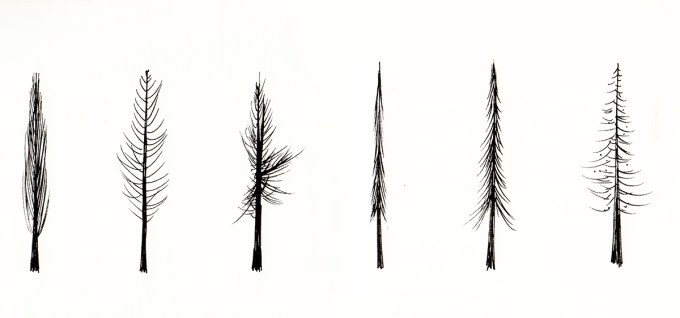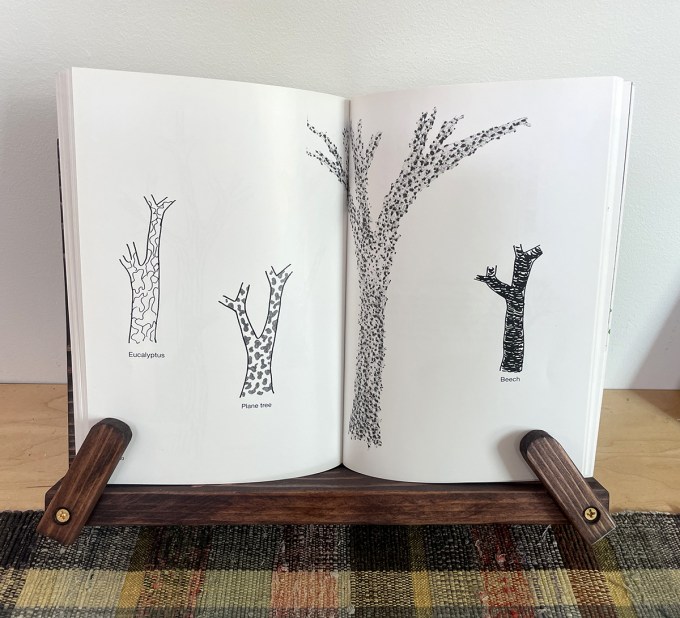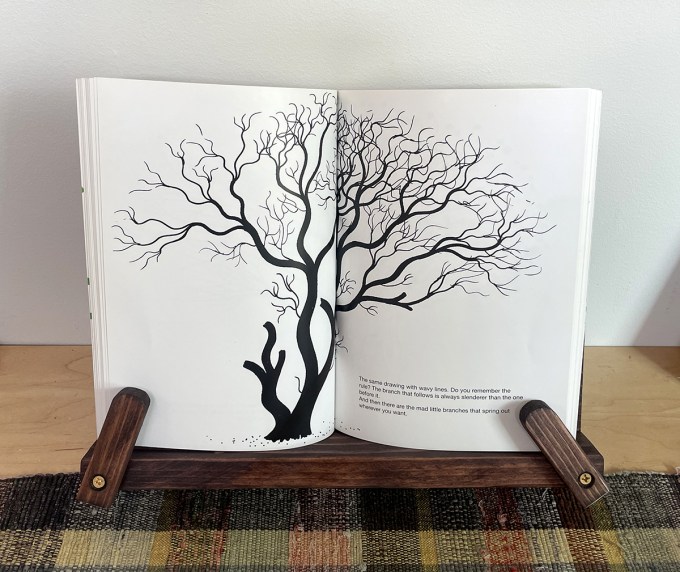
To grow so exactly, a tree would have to live in a place where there was no wind and with the sun always high in the sky, with the rain always the same and with constant nourishment from the ground all the time. There would have to be no lightning flashes nor even any spar changes in temperature, no snow or frost, never too hot or dry.
Munari goes on to draw variations on the basic tree-growth pattern in different species, and variations on each species’ adaptation of the pattern in different specimens.



Here we are at the point where the sky turns dark and a real and proper storm comes, the tree waves frantically in the wind, as if it were afraid. A flash of lightning from the almost black sky hits the tree and disappears in a blaze of light. Through the heavy rain you can see a part of the tree on the ground, a big limb with its smaller branches. All you can hear is the sound of the heavy rain on the leaves.
Exactly two centuries after William Blake issued his searing indictment of inattention and numbness to life — “The tree which moves some to tears of joy is in the eyes of others only a green thing which stands in the way… As a man is, so he sees.” — what emerges from the pages of Munari’s little, largehearted book is an invitation to look at green things more intimately as training ground for loving the world and its variousness more joyously.


As he draws “some hurt and wounded trees,” Munari observes that you can still see the contours of their elemental structure through their scars and healing adaptations.
If they grew in isolation, free from any environmental challenge, all trees would follow perfectly predictable fractal geometries — a pattern so simple anyone could draw it, yet an ideal form not found in nature. This is where the existential meets the scientific and the artistic. Munari observes:

In an oak leaf’s “network of nerves,” he finds a miniature of the entire tree’s branching pattern. (This resemblance, of course, is what fractals explain — the leaf at the tip of the branch at the side of the trunk is just the finest extension of the fractal structure.)
Delighting in the wildest subversions of the pattern — “there are the mad branches too, like in nearly all families” — Munari observes that even through them, you can still discern the fundamental form if you look attentively enough.

Munari — who made some wildly inventive “interactive” picture-books before the Internet was born and who saw graphic literacy as the bridge “between living people and art as a living thing” — annotates the drawing lesson with his spare, poetic prose, contouring the life of a tree:


This endless, life-affirming dialogue between a tree’s predestined structure and its living shape is what the visionary Italian artist, designer, inventor, futurist, and visual philosopher Bruno Munari (October 24, 1907–September 30, 1998) explores in the spare, splendid 1978 gem Drawing a Tree (public library). Inspired by Leonardo da Vinci’s centuries-old diagrammatic study of tree growth, this unexampled masterpiece is a work of visual poetry and existential philosophy in the guise of a simple, elegant drawing guide to the art of trees rooted in their science.
Few things salve sanity better than the awareness that there are infinitely many kinds of beautiful lives, and few places foster this awareness more readily than the forest — this cathedral of infinite possibility, pillared by trees of wildly different shapes and sizes that all began life as nearly identical seeds.



Among the many existential consolations of trees — these teachers in loss as a portal to revelation, these high priestesses of optimism, these virtuosi of improvisation, these emissaries of eternity — is how they self-sculpt their beauty and character from the monolith of challenge that is life. Once planted in its chance-granted location, each tree morphs the basic givens of its genome into a singular shape in response to the gauntlets of its environment: It boughs down low to elude the unforgiving wind, rises and bends to reach the sunlit corner of the umbral canopy, grows a wondrous sidewise trunk to go on living after lightning.
Writing while elsewhere in Europe a refugee was revolutionizing the mathematics of reality with the discovery of fractals — a new science that would come to explain everything from earthquakes to economics markets, most readily visible in nature in trees — Munari deduces a basic growth pattern all trees share: each branch splitting into newer branches, each slenderer than its progenitor.
Almost everywhere a seed falls, a new tree will grow.




Drawing on the long human tradition of seeing ourselves in trees, Munari offers a tender reminder that trees — like us — take their shape and sculpt their individual character in the act of healing from hurt:
The next year the tree is different, wounded. New branches still shoot out though, as if nothing has happened. This is how trees change shape: a flash of lightning, the weight of the snow on the branches, insects that gnaw at the wood… and the tree changes shape.
Because no such idyllic conditions exist in reality, Munari draws the tree as versions of the pattern adapted to various challenges. (Yes. There are infinitely many kinds of beautiful lives.)

At last winter is finished and, from the ground where a seed has dropped, a vertical green blade appears. The sun starts to make itself felt and the green shoots grow. It is a tree, but so small no one recognizes it yet. Little by little it grows tough. It begins to branch, buds germinate on its branches, other branches spring from the buds, other leaves from the branches, and so on. A few years later, that green blade will have become a fine trunk covered in boughs. Later still, it will have produced wide branches which will produce leaves, blossoms and fruit. In autumn it will spread its seeds around, and some will fall beneath it while others will be carried far away by the wind.
For a contemporary counterpart of existential-processing-disguised-as-drawing-lessons, dive into my friend Wendy MacNaughton’s wondrous DrawTogether project for human saplings.
Complement Drawing a Tree with Japanese artist Hasui Kawase’s stunning woodblock prints of trees and some equally, differently stunning drawings of trees by indigenous Indian artists, then revisit Munari’s delightful visual-anthropological guide to Italian hand-gestures.






